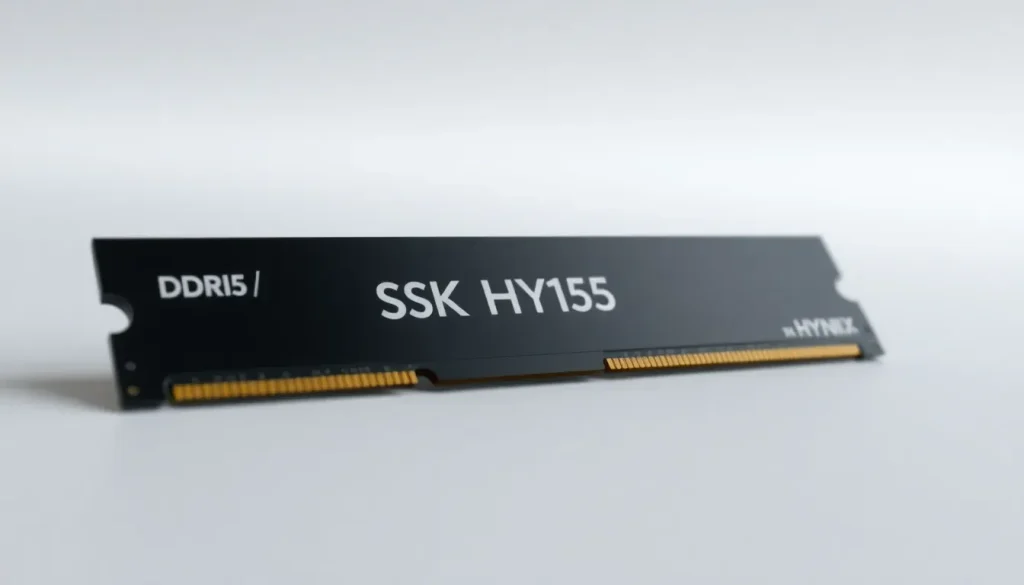SK Hynix DDR5 Inventory Reduced to Two Weeks

The semiconductor industry is currently experiencing a pivotal moment characterized by rapidly evolving demand and supply dynamics. Among the key players is SK Hynix, whose significant strides in the DRAM market are drawing increasing attention. As artificial intelligence (AI) applications surge, the demand for high-bandwidth memory (HBM) is reshaping the landscape of memory production and availability. Understanding these shifts is essential for consumers and businesses alike, especially as they impact pricing and availability of critical components.
In the latest insights from Morgan Stanley, alarm bells are ringing over SK Hynix's plummeting DRAM inventory levels. The company's stock of DRAM is reaching critical lows, effectively marking a "sold-out" status that could have far-reaching implications for the market.
Current state of SK Hynix's DRAM inventory
According to Morgan Stanley, the current inventory of SK Hynix's DRAM (specifically DDR5) has dwindled to a mere two-week supply, which is classified as a "produce-and-ship" level. This means that any new orders will be fulfilled only as quickly as SK Hynix produces new chips.
In their recent earnings report for the third quarter of 2025, SK Hynix revealed a staggering 62% increase in operating profits. This upswing was largely driven by the complete sell-out of their HBM products, underscoring the company's strong position in a competitive market. As demand for HBM continues to rise, it is starting to encroach upon the wafer capacity available for other types of DRAM and NAND products.
Notably, the global delivery times for DDR5 memory modules have also become increasingly stretched, with current estimates ranging between 26 and 39 weeks. This delay not only affects manufacturers but also has implications for end-users who rely on these components for high-performance computing tasks.
Impact of AI on memory demand
The advent of AI technologies has significantly bolstered the demand for commodity memory, including DRAM and NAND. Morgan Stanley reports that the proliferation of AI servers is a critical driver behind this surge. As these technologies become more mainstream, the industry is witnessing a rapid depletion of existing inventories, which is contributing to a price uptrend.
- AI server deployment increasing demand for DRAM.
- Higher prices resulting from reduced supply of memory components.
- Longer delivery times affecting manufacturers and consumers.
Furthermore, SK Hynix has fully booked its DRAM and NAND production capacity through 2026, with the next generation of HBM (HBM4) anticipated to ship by the end of that year. This long-term commitment to production capacity showcases the company’s foresight in addressing the burgeoning demand while also highlighting the challenges that may arise from supply constraints.
Market dynamics: SK Hynix vs competitors
As the leading supplier of HBM products, SK Hynix controls a significant portion of the global market. Current market shares indicate that SK Hynix holds approximately 64% of the HBM market, with Micron at a distant second with 21%, and Samsung trailing with 15%. This dominance places SK Hynix in a pivotal role as they navigate these supply challenges.
| Company | Market Share |
|---|---|
| SK Hynix | 64% |
| Micron | 21% |
| Samsung | 15% |
The shift in memory demand is not just a technical issue; it has real-world implications for hardware manufacturers and end consumers. For instance, as the supply of traditional DRAM products like LPDDR5X diminishes due to prioritization of HBM production, consumers may notice increased prices and reduced availability of devices that rely on these memory types.
Future implications for smartphones and consumer electronics
The soaring demand for HBM is beginning to squeeze out production of other DRAM types, particularly LPDDR5X, which is commonly used in smartphones, tablets, and lightweight laptops. As companies like Xiaomi's President Lu Weibing have pointed out, the rising costs of memory components are shaping product pricing trends across the industry.
- Smartphone prices are likely to increase due to higher memory costs.
- Manufacturers may face production delays for devices reliant on DDR5.
- Consumer electronics could see shifts in product offerings as memory types change.
Insights from industry leaders indicate that the rising costs of storage and memory components are not just temporary but are expected to persist. The current landscape suggests a potential supply shortage by 2026, further complicating the situation for manufacturers and consumers alike.
For those interested in a deeper dive into these memory timing techniques, you may find this video insightful:
As the memory sector adapts to these evolving demands, both consumers and manufacturers must stay informed about potential changes in pricing and availability. The current climate not only highlights the importance of strategic planning in production but also emphasizes the need for flexibility as market conditions continue to shift.




Leave a Reply